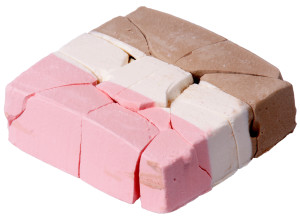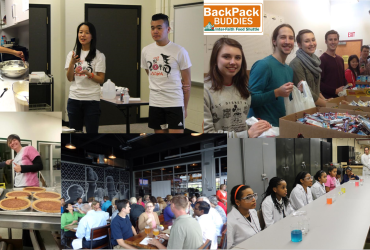By: Amelia Chen
Who among us hasn’t wondered about space food from the minute we begged our parents for that little pack of freeze dried ice cream from the museum gift shop? Despite eating and playing with the block of foam that is freeze dried Neopolitan ice cream, astronaut food has always been a nebulous concept to me. Does anyone remember Zenon, Girl of the 21st Century? That’s what space food was to me – silver foil and geometric shapes and no animal protein.

A childhood delicacy (source: www.wikipedia.com)
Well, after about ten years, I had a chance to attend a quick and informal seminar about the challenges of developing space food from Michele Perchonok, Project Manager and Space Shuttle Food System Manager at the NASA/Johnson Space Center. Space food is comparable to pet or military food, in that taste, nutrition, and stability are crucial when you need to assume you are formulating someone’s only option for food. It’s come a long way from meals that were served in tubes and cubes when it was unknown how much of swallowing and digestion is due to gravity (not a lot), but there still exists many obvious restrictions, an important one being eliminating the possibility of crumbs getting into the machinery. Despite this though, I was impressed by how much variety astronauts have. The eight day menu on the International Space Station (ISS) includes breakfast, lunch, dinner, and snacks, and there are over 200 items, mostly due to all the combinations of coffee and tea. Whatever isn’t already contained in the meals can also be sent up in a “personal preference” pack, which includes special condiments. Although, familiar meals and condiments may not have a familiar flavor due to taste changes in microgravity. Congestion as a result of fluid rise in the body, warmed but not hot foods, and no rise of hot air all contribute to decreased aroma when eating.

Today’s urine is tomorrow’s coffee. (Source: www.healthyfoodstar.com)
If there’s one thing to take away from her presentation, it is the importance of packaging. Developing space food is a balancing act of minimizing vehicle resources with maximizing safety, nutrition, and acceptability. Only so much can be carried by a shuttle, and once you get it up to space, you have to dispose of the waste. The effect of weight on cost is also why recycling water is important when each person needs two liters of water per day. In other words, today’s urine is tomorrow’s coffee.
The possible upcoming 32-month mission to Mars presents many issues regarding shelf life. Compared to ISS, there would be no resupply mission on Mars, and food would have to be prepositioned at least two years prior to the crew’s arrival. Thus, Perchonok talked about the five-year shelf life challenge, which integrates and seeks to optimize aspects of process, package, formula, and environment. For comparison, food has a 12-18 month shelf life on ISS. The objectives include finding an alternative to retort processing that won’t kill color and texture and reducing the total mass to below 145 grams per square meter. Different food matrices and functional foods are being explored to deliver adequate nutrition. And the conditions (temperature, atmosphere, radiation) in space must be considered and possibly used as an advantage. Perchonok mentions that under accelerated shelf life testing, only seven out of 65 foods are expected to be palatable. Significant loss of vitamins is also seen after one year, so she feels that a combination of three-year shelf life packages and bioregenerative supplements is the key to supporting the mission to Mars. With the ability to grow their own food, astronauts will also need ways to cook it. The list of proposed gadgets includes a pressure cooker, juicer, mixer, pasta press, extruder, and tofu mold among other things.
The development of new ways for astronauts to prepare and eat foods is not for a limited outcome though. Perchonok adds that reduced size instruments like the extruder could benefit smaller communities in third world countries. Not to mention, the advancements made by NASA would translate easily to the demands of stable and palatable military food.
References:
Canright, Shelley. “Food for Space Flight” 13 April 2009. NASA. <http://www.nasa.gov/audience/forstudents/postsecondary/features/F_Food_for_Space_Flight.html> 23 February 2015.
Perchonok, Michele. “The Challenges of Developing a Food System for a Mars Mission.” UW-Madison, Department of Food Science Graduate Seminar. Madison, Wisconsin. 9 February 2015.
Watson, Stephanie. “How Space Food Works” 19 February 2008. HowStuffWorks.com. <http://science.howstuffworks.com/space-food1.htm> 24 February 2015.






Leave a Reply